
TREATED clean water like what Richli is producing may help reduce the risk of getting water-borne diseases, like kidney-related, Atty. Rogelio Garcia, who serves as bank director of the Development Bank of the Philippines (DBP), said in interview.
This came as the quality of potable water provided by local government units, including those in refilling stations, for human consumption in the province is a mess, Provincial Board Member Lucille Lagunay said based on her research of bacteriological quality status of water sources by district recently.
“Results of the study show that non-compliance to standards for drinking water continues to undesirably persist throughout the province of Bohol,” she said.
Garcia, who, with his family took a break in Bohol, said DBP is supporting those who are innovators and thinkers who embark on development projects.
He called on people to rally behind those who embark on development projects, like Richli, since they take the risk.
He said that DBP prioritizes willing local investors, who are residents in a place like Richli Corporation which is based here, than those who are big enterprises who embark on big thrusts just to get additional capital.
He said DBP is for, first and foremost, development, saying what used of the term “development” if it doesn’t go for it?
DBP’s fund is people’s money and he is only a trustee of said fund that must be spent for development, Garcia pointed out.
In first district, water system level III showed that “no record” is high in three-month period. 42% of “no record,” 38% potable and 22% non-potable in August 2022; 38% for no record, 42% for potable and 20% for non-potable in September; and 47% for no record, 34% potable and 20 non-potable in October.
In second district of 14 towns, 82% has no record, 18% has potable water and 8% non-potable in August 2022; 71% no record, 24% potable and 5% non-potable in September; and 77% no record, 15 potable and 5% non-potable in October 2022.
In third district of 19 towns with level III system, potable (7%) water is lower than 12% non-potable and 83% has no record in August. Potable (22%) is still lower than 25% non-potable in September; and potable (9%) is still lower than 25% non-potable and 66% no record in October 2022.
“Prolonged inaction on this issue may lead to a rise in enteric (intestinal) illnesses,” Lagunay’s report said.
Water bacteriological status in refilling stations may not be similar in the towns, however.
There are 707 in total refilling station in the entire Bohol. First district has 291; second district, 205; and third district, 211, Lagunay said.
Refilling stations’ potable water (65%) is higher than non-potable at7% and 28%, no record in August 2022. In September 2022, potable is at 68%, non-potable,4% and no record, 27%; and 68% potable, 2% non-potable and 28% no record.
In second district, 48% potable, 12% non-potable and 42% no record n August 2022; 60% potable, 9% non-potable and 21% no record in September; and 53% potable, 7% non-potable and 39% no record in October 2022.
In third district, potable water is high, 62% potable, 8% non-potable and 30% no record in August 2022; 74% potable, 12% non-potable and 14% no record in September 2022; and 71% potable, 8% non-potable and 20% no record in October 2022.
The sorry state of water quality prompted Lagunay to propose a Safe Water Ordinance, which she said, already passed on first reading and it is being referred to an appropriate committee of the provincial board.
The proposed Water Ordinance carries penalties to force the concerned local government units and refilling stations to comply with the mandatory submission of water sampling for laboratory test.
“The proposed Ordinance aims to strengthen the compliance of Drinking Water Service Providers in Bohol with related laws and standards on drinking water such as but not limited to the Sanitation Code of the Philippines (P. D. 856) and the Philippine National Standards for Drinking Water,” Lagunay said. (rvo)



